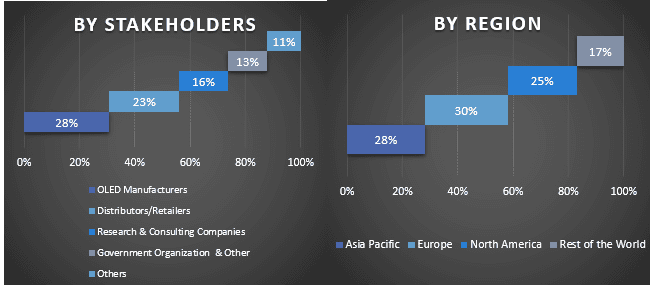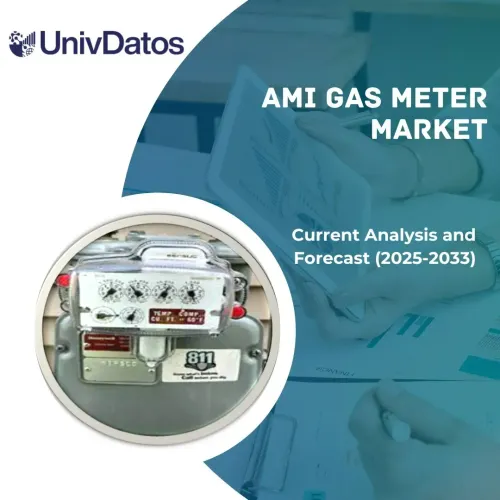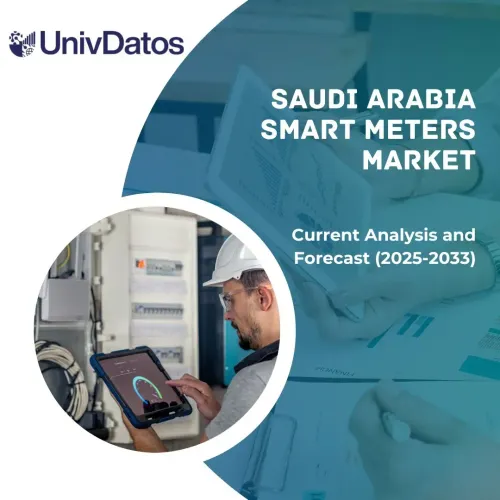- Home
- About Us
- Industry
- Services
- Reading
- Contact Us
Organic Light Emitting Diode (OLED) Market: Current Analysis and Forecast (2022-2030)
Emphasis on Product Type (Display, Lighting); Technology (PMOLED, AMOLED, Transparent OLED, Top-Emitting OLED, Foldable OLED, White OLE); Display Type (Rigid, Flexible, Others); End-User (Consumer Electronics, Automotive, Retail, Industrial, Commercial, Aerospace and Defense, Healthcare); and Region/Country

The Organic Light Emitting Diode (OLED) Market was valued at USD 200 billion in 2030 & is expected to grow at a CAGR of 19% from 2022-2030. Owing to the rising demand for superior displays in wearable devices and smartphones. Further, the surge in the wide variety of display technologies in consumer electronic products such as mobile phones, wearables, IT, and TVs as well as virtual reality, automotive, and signage, OLEDs provide markedly improved performance features compared to LED displays. Further, various display manufacturers across the globe are investing in next-generation OLED technology to strengthen their product portfolio and amplify their position in the market.
For instance: In April 2023, Samsung announced USD 3 billion investment plan in OLED panels for tablets, laptops, and monitors by 2026.
In addition, key players in the market are also launching OLED displays and lighting for end-user industries is also accelerating its market demand. For instance: In 2023, LG Display’s launched META Technology comprises a ‘Micro Lens Array’ that maximizes light emission from the OLED panel and ‘META Booster,’ a brightness-enhancing algorithm. Based on META Technology, the company’s latest OLED displays achieve 60 percent brighter images and 30 percent wider viewing angles than conventional OLED displays, on top of improved energy efficiency.
Some of the major players operating in the market include Universal Display, Advantech Co., Ltd., Innolux Corporation, ams-OSRAM AG, Planar, AU Optronics Corp., LG Display Co., Ltd., Japan Display Inc., General Digital Corporation, and Samsung.
Several M&As along with partnerships have been undertaken by these players to facilitate customers with hi-tech and innovative products/technologies.
Insights Presented in the Report
“Amongst technology, the AMOLED segment held a dominating share of the market in 2021”
Based on technology, the market is segmented into PMOLED, AMOLED, Transparent OLED, Top-Emitting OLED, Foldable OLED, and White OLED. The AMOLED segment acquired an extensive share of the market and is anticipated to grow at an influential CAGR in the forecasted period as well. AMOLED is majorly used for flexible display screens for smartphones and other personal electronic devices as it makes high-resolution screens at a low cost. For instance: In March 2022, Samsung launches three new AMOLED phones, the A33, A53, and the A73 that have a flexible AMOLED display and offers peak brightness.
“Amongst end-use, the consumer electronics held the majority share of the market in 2021”
On the basis of end-use, the OLED market is segmented into consumer electronics, automotive, retail, industrial, commercial, aerospace and defense, and healthcare. The consumer electronics segment acquired the highest share of the market. The soaring technological advancement in electronic devices has escalated the adoption of OLED displays in TVs, smartphones, laptops, monitors, and others to reduce. Moreover, OLEDs consume less power, and lightweight and flexible display offers a wide-angle view of the screen, fast motion, and high contrast.
“North America Caters Significant Share of the Organic Light Emitting Diode (OLED) Market in 2021”
North America acquired a significant share of the COLED market and is expected to witness fueling growth in the forecasted period. It is mainly owing to the gradually increasing demand for massive Tv display panels, improved demand for automobiles and digital signposts, and the deployment of OLED displays in mobile devices. Further, soaring urbanization and economic expansion in the region are propelling the demand for OLED-based lighting. In addition, the rising awareness among consumers of energy-efficient lighting that consumes less power is foreseen to augment the OLED market size.
Organic Light Emitting Diode (OLED) Market Report Coverage

Reasons to buy this report:
- The study includes market sizing and forecasting analysis validated by authenticated key industry experts.
- The report presents a quick review of overall industry performance at one glance.
- The report covers an in-depth analysis of prominent industry peers with a primary focus on key business financials, product portfolios, expansion strategies, and recent developments.
- Detailed examination of drivers, restraints, key trends, and opportunities prevailing in the industry.
- The study comprehensively covers the market across different segments.
- Deep dive regional level analysis of the industry.
Customization Options:
The global Organic Light Emitting Diode (OLED) market can further be customized as per the requirement or any other market segment. Besides this, UMI understands that you may have your own business needs, hence feel free to connect with us to get a report that completely suits your requirements.
Table of Content
Research Methodology for the Organic Light Emitting Diode (OLED) Market Analysis (2022-2028)
Analyzing the historical market, estimating the current market, and forecasting the future market of the global Organic Light Emitting Diode (OLED) market were the three major steps undertaken to create and analyze the adoption of Organic Light Emitting Diode (OLED) in major regions globally. Exhaustive secondary research was conducted to collect the historical market numbers and estimate the current market size. Secondly, to validate these insights, numerous findings and assumptions were taken into consideration. Moreover, exhaustive primary interviews were also conducted, with industry experts across the value chain of the global Organic Light Emitting Diode (OLED) market. Post assumption and validation of market numbers through primary interviews, we employed a top-down/bottom-up approach to forecasting the complete market size. Thereafter, market breakdown and data triangulation methods were adopted to estimate and analyze the market size of segments and sub-segments of the industry pertains to. Detailed methodology is explained below:
Analysis of Historical Market Size
Step 1: In-Depth Study of Secondary Sources:
Detail secondary study was conducted to obtain the historical market size of the Organic Light Emitting Diode (OLED) market through company internal sources such as annual reports & financial statements, performance presentations, press releases, etc., and external sources including journals, news & articles, government publications, competitor publications, sector reports, third-party database, and other credible publications.
Step 2: Market Segmentation:
After obtaining the historical market size of the Organic Light Emitting Diode (OLED) market, we conducted a detailed secondary analysis to gather historical market insights and share for different segments & sub-segments for major regions. Major segments are included in the report as product, technology, display type, and end-use. Further country-level analyses were conducted to evaluate the overall adoption of testing models in that region.
Step 3: Factor Analysis:
After acquiring the historical market size of different segments and sub-segments, we conducted a detailed factor analysis to estimate the current market size of the Organic Light Emitting Diode (OLED) market. Further, we conducted factor analysis using dependent and independent variables such as product, technology, display type, and end-use of the Organic Light Emitting Diode (OLED) market. A thorough analysis was conducted for demand and supply-side scenarios considering top partnerships, mergers and acquisitions, business expansion, and product launches in the Organic Light Emitting Diode (OLED) market sector across the globe.
Current Market Size Estimate & Forecast
Current Market Sizing: Based on actionable insights from the above 3 steps, we arrived at the current market size, key players in the global organic light emitting diode (OLED) market, and market shares of the segments. All the required percentage shares split, and market breakdowns were determined using the above-mentioned secondary approach and were verified through primary interviews.
Estimation & Forecasting: For market estimation and forecast, weights were assigned to different factors including drivers & trends, restraints, and opportunities available for the stakeholders. After analyzing these factors, relevant forecasting techniques i.e., the top-down/bottom-up approach were applied to arrive at the market forecast for 2028 for different segments and sub-segments across the major markets globally. The research methodology adopted to estimate the market size encompasses:
- The industry’s market size, in terms of revenue (USD) and the adoption rate of the Organic Light Emitting Diode (OLED) market across the major markets domestically
- All percentage shares, splits, and breakdowns of market segments and sub-segments
- Key players in the global Organic Light Emitting Diode (OLED) market in terms of product offered. Also, the growth strategies adopted by these players to compete in the fast-growing market
Market Size and Share Validation
Primary Research: In-depth interviews were conducted with the Key Opinion Leaders (KOLs) including Top Level Executives (CXO/VPs, Sales Head, Marketing Head, Operational Head, Regional Head, Country Head, etc.) across major regions. Primary research findings were then summarized, and statistical analysis was performed to prove the stated hypothesis. Inputs from primary research were consolidated with secondary findings, hence turning information into actionable insights.
Split of Primary Participants in Different Regions

Market Engineering
The data triangulation technique was employed to complete the overall market estimation and to arrive at precise statistical numbers for each segment and sub-segment of the global Organic Light Emitting Diode (OLED) market. data was split into several segments & sub-segments post studying various parameters and trends in the areas of the product, technology, display type, and end-use in the global Organic Light Emitting Diode (OLED) market.
The main objective of the Global Organic Light Emitting Diode (OLED) Market Study
The current & future market trends of the global Organic Light Emitting Diode (OLED) market were pinpointed in the study. Investors can gain strategic insights to base their discretion for investments on the qualitative and quantitative analysis performed in the study. Current and future market trends determined the overall attractiveness of the market at a regional level, providing a platform for the industrial participant to exploit the untapped market to benefit from a first-mover advantage. Other quantitative goals of the studies include:
- Analyze the current and forecast market size of the Organic Light Emitting Diode (OLED) market in terms of value (USD). Also, analyze the current and forecast market size of different segments and sub-segments
- Segments in the study include areas of the product, technology, display type, and end-use.
- Define and analysis of the regulatory framework for the Organic Light Emitting Diode (OLED) industry
- Analyze the value chain involved with the presence of various intermediaries, along with analyzing customer and competitor behaviors of the industry
- Analyze the current and forecast market size of the Organic Light Emitting Diode (OLED) market for the major region
- Major countries of regions studied in the report include Asia Pacific, Europe, North America, and the Rest of the World
- Company profiles of the Organic Light Emitting Diode (OLED) market and the growth strategies adopted by the market players to sustain in the fast-growing market
- Deep dive regional level analysis of the industry
Related Reports
Customers who bought this item also bought










